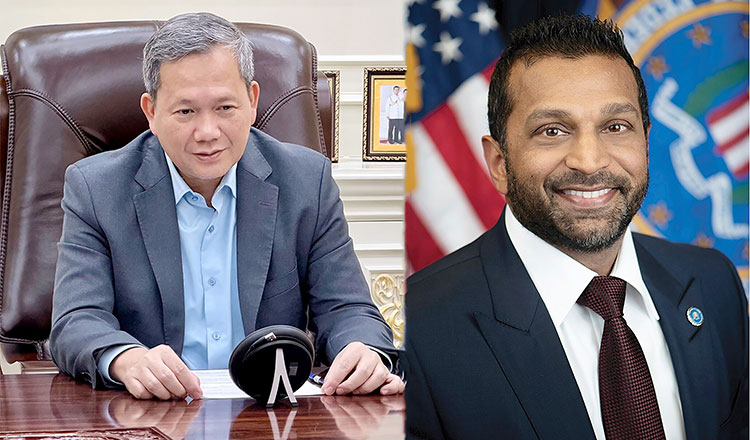
Cambodia and Thailand begin withdrawal of heavy weapons to cement border peace


Preah Vihear province – Following days of intensive military negotiations during a special Regional Border Committee (RBC) meeting, Cambodia and Thailand have agreed to remove three categories of heavy weapons from their shared border—multiple launch rocket systems (MLRS), all types of artillery, and main battle tanks (MBTs).
Cambodia officially began withdrawing heavy artillery from border areas in Preah Vihear province, which borders Thailand’s Ubon Ratchathani and Sisaket provinces, and in Oddar Meanchey province, which is next to Thailand’s Surin and Buriram provinces. The withdrawal began this weekend under the first phase of the RBC agreement with Thailand.
According to the Ministry of National Defence, Royal Cambodian Army (RCA) units have removed SH-1 155mm self-propelled howitzers and Type 90 122 mm multiple rocket launchers from frontline positions, transporting them back to their original bases.
The operation, closely monitored by the ASEAN Observer Team (AOT) led by Malaysia, marks the initial step in a coordinated demilitarisation effort along the Cambodian-Thai frontier.
The removal of heavy and destructive weapons and equipment from the Cambodian side was broadcast live by the National Television of Cambodia (TVK) and shared on social media by both Prime Minister Hun Manet and Senate President Hun Sen, while Thailand was urged to fully implement the peace deal.

The move follows the spirit of the 2nd Special Cambodia-Thailand General Border Committee (GBC) Meeting held in Malaysia on October 23. A special meeting of the Cambodia-Thailand Regional Border Committee (RBC) was held last Friday, during which both parties agreed on a plan for the phased withdrawal of military assets.
According to the plan, the first phase began at 6.45pm yesterday and will continue for three weeks until November 21, with the withdrawal carried out simultaneously by both sides under the observation and verification of the AOT.
Lieutenant General Maly Socheata, spokeswoman for the Ministry of National Defence, said yesterday: “Cambodia firmly hopes that both parties will fully and effectively implement the Joint Declaration in Kuala Lumpur, with sincerity, goodwill, and transparency, to contribute to the promotion of peace, stability, cooperation, development, and the swift return to normalcy—benefitting both countries and their peoples for many generations to come.”
In the first phase, Cambodia will withdraw its weapons in Choam Ksan district and Rovieng district in Preah Vihear province, while the Thai side will do the same at designated locations along the border.
As a gesture of goodwill, both parties began a preliminary partial withdrawal on October 26, removing two armoured vehicles each to their original positions.
Lt Gen Socheata advised the public and media to stay informed of the developments, stressing the importance of transparency and cooperation during the process.
On Friday, an RBC meeting was conducted in O’Smach in Oddar Meanchey province. The meeting was co-chaired by Lieutenant General Pov Heng, Commander of Cambodia’s 4th Military Region, and Lieutenant General Weerayuth Raksilp, Commander of Thailand’s 2nd Army Area. The session was observed by members of the AOT from both sides.

The discussions followed the outcomes of the 2nd Special GBC Meeting convened on October 23 in Kuala Lumpur and were guided by the Joint Declaration signed on October 26, witnessed by Malaysian Prime Minister Datuk Seri Anwar Ibrahim and US President Donald Trump.
The declaration underscored a shared commitment to promoting transparency, trust-building, and responsible management of military postures in the region.
According to a joint statement released after the RBC, both sides reached a consensus on the classification of three categories of heavy weapons that should be withdrawn by both sides. They were MLRS with two or more launch tubes; all types of artillery systems, including 105mm, 122mm, 130mm, 152mm, and 155mm howitzers; and armoured platforms, specifically MBTs.
Both countries affirmed their commitment to upholding the outcomes of the GBC and the principles outlined in the Joint Declaration. They agreed to conduct the phased withdrawal of these weapon categories under the observation and verification of the ASEAN Observer Teams, in accordance with established action plans.
To ensure transparency and accountability, both sides will facilitate verification, documentation, and observation by the AOT and issue regular press releases to update the public on progress. Any concealment or misrepresentation of weapons by either side will be regarded as a lack of sincerity in efforts to restore stability and strengthen bilateral relations.
Phase 1 of the weapons removal process will take place from November 1–21, followed by Phase 2 from November 22 to December 12, and Phase 3 from December 13 –31. Each phase will be conducted under the supervision and verification of the AOT.
RBC Secretariat Meetings for detailed planning and coordination of each phase will be held either virtually or in person, as mutually agreed, to ensure timely consultation and effective implementation.
The nine-point “Joint Declaration” builds on the July 28 ceasefire reached in Putrajaya. It underscores the importance of refraining from the “threat or use of force”, resolving disputes peacefully, and respecting international law and each nation’s sovereignty, territorial integrity, and national identity.
It commits both sides to fully uphold agreements reached through General Border Committee meetings and to implement confidence-building measures along the border to restore trust, foster peaceful dialogue, and rebuild diplomatic relations. The declaration calls for the creation of an AOT to monitor the ceasefire and oversee the removal of heavy weapons from border areas, ensuring transparency and adherence to the terms of reference signed by both governments.
The joint declaration further addresses the need for humanitarian demining efforts to protect civilians and support socio-economic development. Both sides agreed to cease activities that escalate tensions, with Thailand pledging to release prisoners of war as a demonstration of goodwill and mutual trust.
Other terms in the agreement include enhanced cooperation in information sharing, strategic communications, and border controls to prevent transnational crimes affecting both countries and the wider region. The declaration emphasises the importance of leaving past conflicts behind and embarking on a new chapter of neighbourly relations guided by the principles of the United Nations Charter and the ASEAN Charter on peaceful conflict resolution.
The Thai government and military had earlier urged Cambodia to comply with two of four demands in exchange for the release of 18 Cambodian soldiers who were illegally detained a day after the ceasefire.
However, Thailand later expanded its demands, insisting that Cambodia fully implement all four conditions before the soldiers’ release—a move that angered the soldiers’ families, who still have not been informed of a release date.
Bangkok repeatedly demanded the withdrawal of heavy weapons, clearance of landmines, a crackdown on illegal operations, and stricter regulation of border zones. The conditions form what Thailand calls a “roadmap towards peace”, which Cambodia is required to follow before Thailand implements further de-escalation measures.
Yesterday, the National Defence Ministry renewed its call for the release of the Cambodian soldiers who remain in Thai custody after more than three months.
“It has been 96 days since 18 Cambodian soldiers were captured and detained by the Thai military. Cambodia urgently calls on the Thai side to release them as soon as possible, so that they may be safely reunited with their families in accordance with international humanitarian law,” the ministry said in a statement.
The Cambodian government “has been and will continue to make tireless efforts, using all available mechanisms, for the Thai military to release and return our 18 soldiers as quickly and safely as possible, ” it said.
“The Royal Government, the Ministry of National Defence, and the Royal Cambodian Armed Forces will never abandon any of our troops under any circumstances.”
Thailand has said that the release of the Cambodian soldiers will follow legal and diplomatic procedures, marking a step forward in efforts to ease tensions along the shared border.
As reported by Thai media, Thai Prime Minister Anutin said Thai authorities would review each case in coordination with Phnom Penh to determine the appropriate course of action. He dismissed reports that the detained Cambodian soldiers had sought political asylum, stressing that such claims were not part of the recently signed bilateral declaration between the two governments.
“If the 18 officers are deemed to be of no further use to Thailand, they will be repatriated,” Anutin said, adding that the process would follow international regulations.
Thailand’s Deputy Defence Minister, Lieutenant General Adul Boonthamcharoen said the soldiers’ release was part of a three-stage disarmament and de-escalation framework agreed upon by both sides. Within the first 21 days, Cambodia must withdraw heavy weapons to their bases, and Thailand must do the same.
Lt Gen Adul said the repatriation of the detained soldiers would depend on Cambodia’s compliance with the withdrawal plan and continued landmine clearance along the border.
Anutin noted that military leaders on both sides remained in constant communication to ensure the responsible withdrawal of heavy weaponry and to coordinate mine-removal operations, which are “essential for the safety of those living along the border.”
He added that both nations were implementing the joint declaration “under the world’s scrutiny”, reflecting their shared commitment to easing tensions.
Addressing concerns over the disputed Ta Krabei Temple area, Anutin said the two nations would continue resolving border issues through existing mechanisms such as the Joint Boundary Commission (JBC), RBC, and GBC, emphasising that “diplomacy, not confrontation” would guide their approach.
Anutin also responded to domestic criticism over claims that the Thai military relied on privately donated equipment, saying the Defence Ministry’s budget remained among the country’s largest.
Donations, he said, were “a reflection of unity and patriotism,” not a sign of inadequate funding.
As for the reopening of Thailand’s border checkpoints with Cambodia, Anutin said no such discussions had occurred. “If I remain in government, no border checkpoint will reopen without public consent,” he said, adding that national security will not be compromised.
To fully implement the four points, the Cambodia–Thailand Joint Coordinating Task Force (JCTF) on Humanitarian Demining convened a virtual meeting on Thursday to discuss and identify a pilot area in priority border zones for humanitarian mine clearance.
According to Lt Gen Socheata, the meeting was held in line with the spirit of the First Special Meeting of the GBC and will be implemented in accordance with the standard operating procedures of the JCTF.
Both sides agreed that the identification of pilot areas for demining operations will be based on mutually accepted criteria, and respective positions. The humanitarian demining activities will not affect the ongoing survey and demarcation of the land boundary—matters that remain under the JBC’s jurisdiction.
The meeting noted that any areas cleared of mines will be maintained in their original state until a decision by the JBC. The entire demining process will strictly adhere to the principles of sovereignty and territorial integrity.Cr:KhmerTimes








